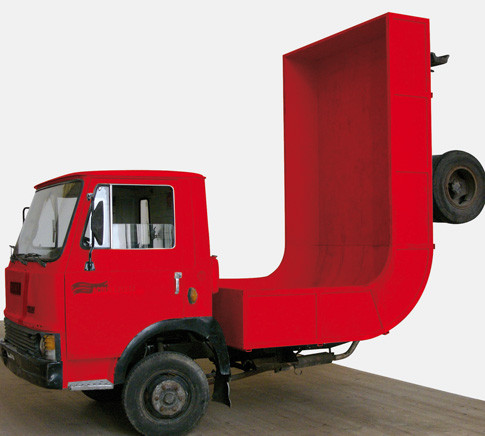CAR CULTURE. Media of Mobility
18 Jun 2011 - 29 Jan 2012

An exhibition at the ZKM | Media Museum
Erwin Wurm: “Truck”, 2011
(installation view Kunstraum Innsbruck, 2006)
© Erwin Wurm, photo: Colin Davison
The opening of the Karlsruhe Automobile Summer 2011 Program and the Anniversary of the City
The technologies of the 20th and 21st centuries facilitate new forms of independence from place. With Media of Mobility, the exhibition “CAR CULTURE” takes up the theme of mobility in a twofold sense: the material mobility of the body, cars and machines, stands juxtaposed to the immaterial mobility of signals, telegraphy, television, radio, telephone and Internet.
One hundred and twenty five years ago witnessed the construction of the first automobile by Carl Benz, and the existence of electromagnetic waves by Heinrich Hertz was proved. Thus, in Baden there began a development spanning from automobile to mobile telephone – to unlimited individual mobility.
As a cult object and symbol of individual freedom, the car is, par excellence, the medium of mobility that enjoys an exceptional position due to its being available at all times. In the exhibition, the ground floor of the ZKM | Media Museum is transformed into a parking lot for immobile cars as sculptures. From Hans Hollein’s idea of a building constituted of automobiles realized for the first time at the ZKM, via the car as the origin and mirror of processes of general social transformation, for instance, in “Aktion 20.000 km” by HA Schult, through to the reinterpretation of the automobile simply as a mode of transportation to an apparently sentient object such as Olaf Mooij’s “Brain Car” – artistic approaches show in a unique manner the social consequences of the development of the automobile.
The first phase in the industrialization of our society was marked by physical mobility, namely, by the material overcoming of spatial and temporal distance. This individual and collective means of transportation was primarily concerned with the conveyance of goods and persons.
The birth of virtual mobility likewise dates back to the industrial age, albeit that it first reached its temporary peak as late as the postindustrial era. The decisive turning point in the transition from physical to virtual mobility was the separation between messenger (body) and message (sign). Traveling signs, bodiless messages, are the insignia of virtual mobility. In this respect, virtual mobility is not only a continuation and extension of physical mobility: ideally, the former should make the latter superfluous.
For this reason, in conjunction with the artistic interpretations of the automobile the exhibition “CAR CULTURE. Media of Mobility” presents, the technical developments which first made possible the mobility of information will also be presented. The technical history of radio technology ‘from Hertz to Mobile’ can be viewed on the first floor. Until today, the successful radio experiments for the transfer of electromagnetic waves as carried out by Heinrich Hertz at the Technical University of Karlsruhe, in 1886 are considered the nascence of this development. The road, originating in these experiments, through to the installments of cellular mobile radio networks and mobile telephones of the present-day has been long.
Both developments are intimately connected with one another, and both originated here in Baden. In Baden-Württemberg, one of the world’s largest automobile manufacturing bases, the ZKM will be using the opportunity of the Automobile Summer to present the worldwide social, artistic and economic ramifications of “CAR CULTURE” from a new perspective and in a large-scale exhibition.
A catalog will be published in conjunction with the exhibition entitled:
CAR CULTURE. Media of Mobility, Peter Weibel (ed.), ZKM | Center of Art and Media, 2011, ca. 350 pages, incl. numerous illustrations.
Note to the editorial departments:
The exhibition is to take place as part of the Automobile summer 2011, as initiated by the state of Baden-Württemberg. The exhibition “CAR CULTURE. Media of Mobility” is sponsored by the Baden-Württemberg Foundation and the City of Karlsruhe, as well as by the companies Mercedes-Benz and Bosch.
Curators: Peter Weibel, Bernhard Serexhe
Co-curators: Manfred Hauffen (apps), Franz Pichler (radio technology)
Participating artists (Selection):
Franz Ackermann, Ant Farm, University of Arts and Design Karlsruhe: „petrolectrical“, Miquel Barceló, Gottfried Bechthold, Ecke Bonk, Frieder Butzmann, John Chamberlain, Plamen Dejanoff, Jean-Michel Dejasmin, Götz Dipper, Elmgreen & Dragset, Friedemann Flöther, Zaha Hadid, Hochschule Karlsruhe – Technik und Wirtschaft: „E-Quickie“, HS Pforzheim: „Transportation Design“, Severin Hofmann / David Moises / Leo Schatzl, Hans Hollein, Li Hui, Christoph Keller, Ivan Kožarić, Köbberling / Kaltwasser, Hans Kupelwieser, Jean-Jacques Lebel, Bernd Lintermann, Alvin Lucier, Michaela Melián, Olaf Mooij , Hans Op de Beek, Axel Philipp, Fabrizio Plessi, Tobias Rehberger, Stefan Rohrer, Valentin Ruhry, Peter Sauerer, Pavel Schmidt, HA Schult, Georg Seibert, Sergej Šehovcov, Gustav Troger, Lieven van Velthoven, Sven Voelker / Kay Michalak, Wolf Vostell, Peter Weibel, Paweł Wocial, Erwin Wurm, Yin Xiuzhen.
